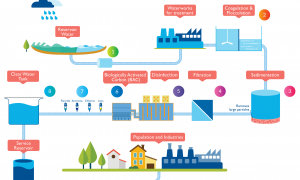🕑 Reading time: 1 minute
A spillway is a hydraulic structure built at a dam site for diverting the surplus water from a reservoir after it has been filled to its maximum capacity. Spillways are classified into different types on the basis of the arrangement of the control structure, a conveyance channel and a terminal structure. In this article, we will discuss in brief all the different types of spillways with pictures.
Contents:
Types of Spillways
Different types of spillways are as follows:
- Straight Drop Spillway
- Ogee Spillway
- Shaft Spillway
- Chute Spillway
- Side Channel Spillway
- Siphon Spillway
- Labyrinth Spillway
1. Straight Drop Spillway
A Straight drop spillway consists of low height weir wall having its downstream face roughly or perfectly vertical. When the water level in the reservoir rises above the normal pool level, the surplus water falls freely from the crest of the weir and hence it is known as Straight drop spillway or free overfall spillway.

To prevent the scouring of downstream bed from falling water jet, an artificial pool with a concrete apron and low secondary dam is constructed on the downstream side. Proper ventilation should be provided on the underside portion of a falling jet to prevent pulsating and fluctuating effects.
Sometimes, an overhanging projection is provided on the crest of the weir to prevent the entrance of small discharges onto the face of the weir wall. Straight drop spillways are most suitable for thin arch dams, earthen dams or bunds.

2. Ogee Spillway
Ogee spillway, as the name says, represents the shape of the downstream face of the weir. It is an improved form of a straight drop spillway. In this case, the downstream face of the weir is constructed corresponding to the shape of lower nappe of freely falling water jet which is in ogee shape.
The ogee shape of the downstream face is designed on the basis of the principle of a projectile. In general, the shape of lower nappe of the water jet is not constant for all water heads hence, the shape obtained for the maximum head is taken into account while designing ogee spillway.

Whenever there is surplus water, it will be freely disposed of through ogee spillway along its ogee shaped crest hence it can also be called as an overflow spillway. Ogee spillways are most commonly used in case of gravity dams, arch dams, buttress dams, etc. For gravity dams, it is generally located within the dam body.
3. Shaft Spillway
A Shaft spillway is a type of spillway which consists of a vertical shaft followed by a horizontal conduit. The surplus water enters into the vertical shaft and then to the horizontal conduit and finally reaches the downstream of the channel.

The shaft constructed is either artificial or natural. Excavation for the natural shaft is possible only when the hard rocky layer is present on the upstream side. The horizontal conduit either passes through the dam body or through the foundation of the dam.
In the case of large projects, the inlet hole of the vertical shaft is specially shaped which is called as morning glory or glory hole of the spillway. Hence, shaft spillway is also called as Morning glory spillway or Bell Mouth spillway. Shaft spillway is recommended when there is no space to provide for other types of spillways such as ogee spillway, straight drop spillway, etc.

4. Chute Spillway
Chute spillway is a type of spillway in which surplus water from upstream is disposed to the downstream through a steeply sloped open channel. It is generally constructed at one end of the dam or separately away from the dam in a natural saddle in a bank of the river.
Chute spillway is suitable for gravity dams, earthen dams, rockfill dams, etc. But it is preferred when the width of the river valley is very narrow. The water flows along the steeply sloped chute or trough or open channel and reaches the downstream of the river. Chute spillway is also called as trough spillway or open channel spillway.
The slope of chute spillway is designed in such a way that the flow should be always in supercritical condition. To dissipate energy from the falling water, energy dissipators can be provided on the bed of chute spillway.

5. Side Channel Spillway
Side channel spillway is similar to chute spillway but the only difference is the crest of side channel spillway is located on one of its sides whereas crest of chute spillway is located between the side walls. In other words, the water spilling from the crest is turned to 90 degrees and flows parallel to the crest of side channel spillway unlike in chute spillway.

Side channel spillways are preferred over chute spillways when flanks of sufficient width are not available, usually to avoid heavy cutting. The angle of turn of water flow after passing weir crest can also be kept between 00 and 900.

6. Siphon Spillway
A siphon spillway is a type of spillway in which surplus water is disposed to downstream through an inverted U shaped conduit. It is generally arranged inside the body or over the crest of the dam.
In both types of siphon spillways, air vents are provided at the bent portion of the upper passageway to prevent the entrance of water when the water level is below the normal poll level. Whenever the level rises above normal pool level, water enters into the conduit and is discharged to the downstream of the channel by siphonic action.

7. Labyrinth Spillway
A labyrinth spillway is a type of spillway in which the weir wall is constructed in a zigzag manner in order to increase the effective length of the weir crest with respect to the channel width. This increase in effective length raises the discharge capacity of the weir and hence higher water flow at small heads can be conveyed to the downstream easily.



